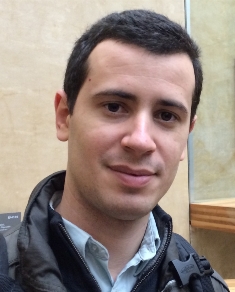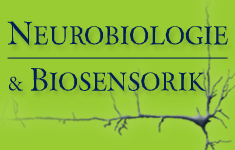- GU Home
- Biowissenschaften
- Institute und Einrichtungen
- Institut ZN
- Arbeitskreise
- Abt. Kössl
- Group Members
- Dr. Julio César Hechavarria Cueria
About me
I studied Biology at the University of Havana and Cognitive Neurosciences at the Cuban Neuroscience Center. In 2010, I joined the Lab from Manfred Kössl in Frankfurt as PhD student, with funding from the German Academic Exchange Service (DAAD). During my studies in Cuba and during my PhD in Frankfurt, I conducted electrophysiology experiments in bats with the goal of understanding the neural specializations that enable echolocation in this fascinating animal group. In 2015 I started to co-lead the AC lab with Manfred Kössl, after obtaining my first DFG grant for studying fronto-temporal network dynamics in the bat brain. In the AC lab, I am in charge of experiments dealing with electrophysiology and bioacoustics in bats, gerbils and humans. My main research goal is to understand the underpinnings of sensory computations in the mammalian brain from an evolutionary, neuroethology-related, perspective.
Projects
A large part of our research also deals with the mechanisms by which the brain is able to extract and piece together the information enclosed in natural sound streams.
We always have several research projects running in parallel. These projects are conducted by PhD, master, and bachelor students under my supervision, and the supervision of Prof. Manfred Kössl. Currently ongoing research projects include:
- Processing of echolocation information in noisy environment
- Topography of information representation in the bat auditory midbrain
- Brain rhythms in the auditory cortex and their relation to spiking activity
- Responses to natural sound streams in the fronto-temporal network
- Fronto-temporal oscillations and their relation to vocalization production in bats
- Fronto-striatal oscillations and their relation to vocalization production and food ingestion in bats
- Properties of bat distress vocalizations and their similarities/differences to human screams
- Processing of screams in the human brain
- Can respiration and olfaction modulate acoustic processing in the bat brain?
Cross-modal audio-visual processing in the bat brain
External funding sources
DFG: grant number HE 7478/1-1
Publications
López-Jury, L.; García-Rosales, F.; González-Palomares, E.; Wetekam, J.; Hechavarria, J.C., (2022):
A neuron model with unbalanced synaptic weights explains asymmetric effects of ketamine in auditory cortex.
bioRxiv,Article Accepted in PLoS Biology.
García-Rosales, F.; López-Jury, L.; González-Palomares, E.; Wetekam, J.; Cabral-Calderín, Y.; Kiai, A.; Kössl, M.; Hechavarría, J.C., (2022):
Echolocation-related reversal of information flow in a cortical vocalization network.
Nature Communications, 13(1): 1-15.
Wetekam, J.; Hechavarría, J. C.; Lopez-Jury, L.; Kössl, M., (2021):
Correlates of deviance detection in auditory brainstem responses of bats
European Journal of Neuroscience,55 (6): 1601-1613.
Lopez-Jury, L.; Garcia-Rosales, F.; Gonzalez-Palomares, E.;, Kössl, M.; Hechavarria, J. C., (2021):
Acoustic context modulates natural sound discrimination in auditory cortex through frequency specific adaptation.
The Journal of Neuroscience, 41 (50): 10261–10277.
González-Palomares, E.; López-Jury L.; Wetekam, J.; Kiai, A.; García-Rosales, F.; Hechavarria, J. C., (2021):
Male Carollia perspicillata bats call more than females in a distressful context
Royal Society Open Science, 8 (5)
Beetz, M. J.; Kössl, M.; Hechavarría, J. C., (2021):
The frugivorous bat Carollia perspicillata dynamically changes echolocation parameters in response to acoustic playback.
Journal of Experimental Biology, 224 (6)
Enhanced representation of natural sound sequences in the ventral auditory midbrain.
Macias, S.; Bakshi, K.; Garcia-Rosales, F.;, Hechavarria, J. C.; Smotherman M., (2020):
Temporal coding of echo spectral shape in the bat auditory cortex.
Plos Biology, 18 (11): e3000831
Garcia-Rosales, F.; Lopez-Jury, L.; Gonzalez-Palomares, E.; Cabral-Calderin, Y.; Kössl, M.; Hechavarria, J. C., (2020):
Phase-amplitude coupling profiles differ in frontal and auditory cortices of bats.
European Journal of Neuroscience, 00: 1-19.
Scientific Reports,10 (1): 1-20.
Frontiers in
Plos Biology, 18 (3): e3000658.
Auditory brainstem responses in the bat Carollia perspicillata: threshold calculation and relation to audiograms based on otoacoustic emission measurement.
Journal of Comparative Physiology A, 206: 95-101.
Modified synaptic dynamics predict neural activity patterns in an auditory field within the frontal cortex.
European Journal of Neuroscience, 51 (4): 1011-1025.
Laminar specificity of oscillatory coherence in the auditory cortex.
Brain Structure and Function, 224 (8): 2907-2924.
Adaptations in the call emission pattern of frugivorous bats when orienting under challenging conditions.
Low-Frequency Spike-Field Coherence Is a Fingerprint of Periodicity Coding in the Auditory Cortex.
Neuronal coding of multiscale temporal features in communication sequences within the bat auditory cortex.
Communications Biology, 1: 200.
Robustness of cortical and subcortcal processing in the presence of natural masking sounds.
Scientific Reports, 8: 6863.
Smart bats click twice.
Beetz, M. J.; Kordes, S.; García-Rosales, F.; Kössl, M.; Hechavarría, J. C., (2017):
Processing of Natural Echolocation Sequences in the Inferior Colliculus of Seba's Fruit Eating Bat, Carollia perspicillata.
eNeuro, 4 (6): 314-317.
Martin, L. M.; García-Rosales, F.; Beetz, M. J.; Hechavarría, J. C., (2017):
Processing of temporally patterned sounds in the auditory cortex of Seba's short-tailed bat, Carollia perspicillata.
European Journal of Neuroscience, 46 (8): 2365-2379.
Schaefer, M. K.; Kössl, M.; Hechavarria, J. C., (2017):
Laminar differences in response to simple and spectro-temporally complex sounds in the primary auditory cortex of ketmine-anesthetized gerbils.
Plos One, 12 (8): e0182514.
Kössl, M.; Hechavarría, J. C., (2017):
Die Zeitkarte im Gehirn - Wie Feldermäuse Raum in Zeit übersetzen.
Forschung Frankfurt, 1.2017.
Hechavarría, J. C.; Beetz, M. J.; Macias, S.; Kössl, M., (2016):
Vocal sequences suppress spiking in the bat auditory cortex while evoking concomitant steady-state local field potentials.
Scientific Reports, 6: 39226.
Beetz, M. J.; Hechavarría, J. C.; Kössl, M., (2016):
Cortical neurons of bats respond best to echoes from nearest targets when listening to natural biosonar multi-echo streams.
Scientific Reports, 6: 35991.
Macías, S.; Hechavarría, J. C., (2016):
Short delays and low pulse amplitudes produce widespread activation in the target-distance processing area of auditory cortex. of the mustached bat.
Macías, S.; Hechavarría, J. C.; Kössl, M., (2016):
Sharp temporal tuning in the bat auditory midbrain overcomes spectral-temporal trade-off imposed by cochlear mechanics.
Scientific Reports, 6: 29129.
Beetz, M. J.; Hechavarría J. C.; Kössl, M., (2016):
Temporal tuning in the bat auditory cortex is sharper when studied with natural echolocation sequences.
Scientific Reports, 6: 29102.
Mihova, D.; Hechavarría, J. C., (2016):
The electrocardiogram signal of Seba's short-tailed bat, Carollia perspicillata.
Journal of Comparative Physiology A, 202 (7): 517-526.
Hechavarría, J. C.; Beetz, M. J.; Macias, S.; Kössl, M., (2016):
Distress vocalization sequences broadcasted by bats carry redundant information.
Journal of Comparative Physiology A, 202: 503-15.
Macías, S.; Mora, E. C.; Hechavarría, J. C.; Kössl, M., (2016):
Echo-level compensation and delay tuning in the auditory cortex of the mustached bat.
European Journal of Neuroscience, 43 (12): 1647-1660.
Macías, S.; Hechavarría, J. C.; Kössl, M., (2016):
Temporal encoding precision of bat auditory neurons tuned to target distance deteriorates on the way to the cortex.
Journal of Comparative Physiology A, 202 (3): 195-202.
Abstracts:
Beetz, M. J.; Hechavarría, J. C.; Kössl, M., (2016):
Precise target-distance coding during cortical suppression in echolocating bats.
"Twelfth Congress of the International Society of Neuroethology" (Montevideo, Uruguay, 30th March- 3rd April 2016).
Schaefer, M.; Hechavarria, J. C.; Koessl, M., (2015):
Quantification of mid and late evoked sinks in laminar current source density profiles of columns in the primary auditory cortex. frontiers.
Frontiers in Neural Circuits, 9: 52.
Kössl, M.; Hechavarria, J. C.; Voss, C.; Schaefer, M.; Vater, M., (2015):
Bat auditory cortex - model for general mammalian auditory computation or special design solution for active time perception?
European Journal of Neuroscience, 41 (5): 518-532.
Macías, S.; Hernández-Abad, A.; Hechavarría, J. C.; Kössl, M.; Mora, E. C., (2015):
Level-tolerant duration selectivity in the auditory cortex of the velvety free-tailed bat Molossus molossus.
Journal of Comparative Physiology A, 201: 461-471.
Abstracts:
Beetz, M. J.; Hechavarría, J. C.; Kössl, M., (2015):
About how cortical neurons of bats cope with fast echolocation sequences: Multi-electrode and single-electrode recordings with natural echolocation stimuli.
“Eleventh Göttingen Meeting of the German Neuroscience Society" (Göttingen, Germany, 18.-21. March 2015).
Tone-deaf ears in moths may limit the acoustic detection of two-tone bats.
Brain Behavior and Evolution, 83 (4): 275-285.
Footprints of inhibition in the response of cortical delay-tuned neurons of bats.
Journal of Neurophysiology, 111 (8): 1703-1716.
Narrow sound pressure level tuning in the auditory cortex of the bats Molossus molossus and Macrotus waterhousii.
Hearing Research, 309: 36-43.
Neural maps for target range in the auditory cortex of echolocating bats.
Current Opinion in Neurobiology, 24: 68-75.
Hechavarría, J. C.; Macías, S.; Vater, M.; Voss, C.; Mora, E. C.; Kössl, M., (2013):
Blurry topography for precise target-distance computations in the auditory cortex of echolocating bats.
Nature Communications, 4: 2587.
Mora, E. C.; Macías, S.; Hechavarría, J. C.; Vater, M.; Kössl, M., (2013):
Evolution of the heteroharmonic strategy for target-range computation in the echolocation of Mormoopidae.
Frontiers in Physiology, 4: 141.
Macías, S.; Hechavarría, J. C.; Kössl, M.; Mora, E. C., (2013):
Neurons in the inferior colliculus of the mustached bat are tuned both to echo-delay and sound duration.
Neuroreport, 24 (8): 404-409.
Macías, S.; Mora, E. C.; Hechavarría, J. C.; Kössl, M., (2013):
Properties of echo delay-tuning receptive fields in the inferior colliculus of the mustached bat.
Hearing Research, 286 (1-2): 1-8.
Hechavarría, J. C.; Macías, S.; Vater, M.; Mora, E. C.; Kössl, M., (2013):
Evolution of neuronal mechanisms for echolocation: specializations for target-range computation in bats of the genus Pteronotus.
The Journal of the Acoustical Society of America, 133 (1): 570-578.
Properties of echo delay-tuning receptive fields in the inferior colliculus of the mustached bat.
Macías, S.; Mora, E.
C.; Hechavarría, J. C.; Kössl, M., (2011):
Duration tuning in the inferior colliculus of
the mustached bat.
Journal of Neurophysiology, 106 (6): 3119-3128.
Sound evoked oscillation and paradoxical latency shift in the inferior
colliculus neurons of the big fruit-eating bat, Artibeus jamaicensis.
Contact
Dr. Julio César Hechavarria Cueria
Goethe-University Frankfurt am Main
Biologicum, building part A, 3rd floor
Max-von Laue-Straße 13
60438 Frankfurt am Main
Room: 3.120
Email: hechavarria(at)bio.uni-
frankfurt.de
Phone: +49 69 / 798-42062
- Aktuelles und Presse
- Pressemitteilungen
- Öffentliche Veranstaltungen
- Uni-Publikationen
- Aktuelles Jahrbuch
- UniReport
- Forschung Frankfurt
- Aktuelle Stellenangebote
- Frankfurter Kinder-Uni
- Internationales
- Outgoings
- Erasmus / LLP
- Goethe Welcome Centre (GWC)
- Refugees / Geflüchtete
- Erasmus +
- Sprachenzentrum oder Fremdsprachen
- Goethe Research Academy for Early Career Researchers
- Forschung
- Research Support
- Forschungsprojekte, Kooperationen, Infrastruktur
- Profilbereich Molecular & Translational Medicine
- Profilbereich Structure & Dynamics of Life
- Profilbereich Space, Time & Matter
- Profilbereich Sustainability & Biodiversity
- Profilbereich Orders & Transformations
- Profilbereich Universality & Diversity







